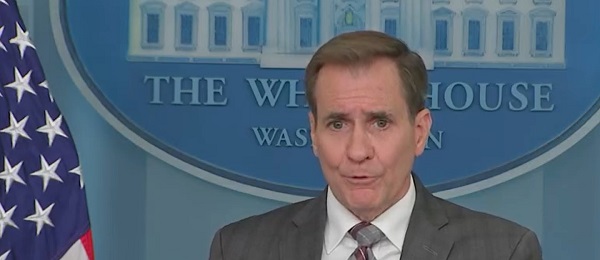conflict
The West Is Playing With Fire In Ukraine

National Security Communications Adviser John Kirby
From the Daily Caller News Foundation
As wars tend to do, the battle over Ukraine continues to escalate.
It was reported this week that North Korean soldiers in the conflict total 10,000 thus far and that Russia has rewarded Pyongyang by sending its excellent air defense systems to the Korean Peninsula in exchange.
Last month, the National Security Council spokesman, John Kirby, warned that any North Korean troops fighting in the conflict would be, “fair game and fair targets.”
His green light delivered this week when “a high-ranking North Korean military officer [became] a casualty” according to a Wall Street Journal story on Thursday. That strike was allegedly conducted with British Storm Shadow missiles.
Just these recent events further entangle the U.S., U.K., North Korea, South Korea, and China within the Russia-Ukraine conflict.
But the week’s biggest Ukraine news rattled many Americans — the Biden administration authorized Ukraine to strike targets within Russia with the American-made Army Tactical Missile System (ATACMS).
“The missiles will speak for themselves,” Ukrainian President Volodymyr Zelenskyy boasted.
They sure will. First of all, the U.S. doesn’t have many of the $1.3 million missiles to lob around. U.S. Indo-Pacific Command Commander Admiral Samuel Paparo warned an audience at the Brookings Institute this week that the conflicts in the Middle East and Ukraine are “now eating into stocks … and to say otherwise would be dishonest.”
I’ve met and been briefed by Admiral Paparo, who is one of the most positive and straight-talking flag officers in our military. If he is publicly ringing the warning bell, U.S. policy leaders should take heed.
Putin did not take the news of the ATACMS well. In response, he announced the use of a hypersonic ballistic missile on Thursday, carefully noting that it didn’t carry a nuclear warhead. The unspoken part: next time, it might.
What’s the goal in Biden’s escalation? It seems the White House is trying to prevent the inevitable or blame Trump for Ukraine’s upcoming defeat.
What they won’t admit is that the metrics of the war are not in Ukraine’s favor, and frankly never have been. No supersonic missile will change the immutable: Russia boasts a population five times Ukraine’s and when it comes to war materiel, Russia is winning. Despite Biden’s attempt to hobble the Russian economy, Putin’s war industry is outproducing the West by three times in the basic munitions needed to prosecute a land battle.
But aren’t Russians dying en mass on the battlefield?
Western leaders keep touting Russia’s high death toll, which estimates now place at 600,000. To military strategists here in the United States, such a human cost is unimaginable. Add up every American combat death going back 160 years through the Gulf Wars, Afghanistan, Vietnam, Korea, World War II, World War I, and even the Union combat deaths in the Civil War, and the number does’t reach what Russia has lost in the past 1,000 days.
American and NATO leaders are foolish to underestimate Russian resolve.
Since its initial blundering and poorly-executed invasion of Ukraine in 2022, Russia has recovered from its mistakes, Russian public support for the war remains high, and the Russian economy hasn’t fallen apart. Putin may have lost the virtue-signaling battle of Ukrainian flag lapel pins, but make no mistake: he’s on a path to win the war.
Biden’s deputy Pentagon press secretary, Sabrina Singh, says don’t worry. On Thursday she told reporters the administration was sending as much American weapons and support to Ukraine as it can muster, “in the weeks and months ahead left of this administration. So, that’s what we’re really focused on.”
What did she make of Putin’s nuclear threat? “I mean, you know, we’ve seen this type of, you know, dangerous, reckless rhetoric before from President Putin,” Singh said.
“I mean, you know?” No, we don’t know. The world hasn’t seen nuclear threats like this since Harry S. Truman demanded Japan surrender.
For anyone worried about the state of our national security, January 20th can’t come quickly enough.
Artificial Intelligence
AI Drone ‘Swarms’ Unleashed On Ukraine Battlefields, Marking New Era Of Warfare


From the Daily Caller News Foundation
Artificial intelligence-powered drones are making their first appearances on the battlefield in the Russia-Ukraine war as warfare creeps closer to full automation.
In bombardments on Russian targets in the past year, Ukrainian drones acting in concert were able to independently determine where to strike without human input.
It’s the first battlefield use of AI “swarm” technology in a real-world environment, a senior Ukrainian official and Swarmer, the company who makes the software, told the Wall Street Journal in a Tuesday report. While drones have increasingly defined modern battlefields, swarms until now had been confined to testing rather than combat.
“You set the target and the drones do the rest,” Swarmer Chief Executive Serhii Kupriienko told the WSJ. “They work together, they adapt.”
So far, the Swarmer technology has been used hundreds of times to target Russia assets, but was first used a year ago to lay mines on the front, the Ukrainian official told the WSJ. The software has been tested with up to 25 drones at once, but is usually utilized with only three.
Kupriienko told the WSJ that he was preparing to test up to 100 drones at once with the linking software.
A common arrangement used on the battlefield includes one reconnaissance drone to scout out the target and two explosive drones delivering the payload on target, the official told the WSJ.
While Western nations such as the U.S., France and the United Kingdom are also pursuing drone swarm technology, they have not deployed swarm technology on the battlefield the way Ukraine has, according to the WSJ. Currently, autonomous weapons are not regulated by any international authority or binding agreement, but ethical concerns around the technology has led many to call for increased regulation of weapons like the Swarmer system.
The Ukrainian Ministry of Foreign Affairs did not immediately respond to the Daily Caller News Foundation’s request for comment.
conflict
Trump Pentagon Reportedly Blocking Ukraine From Firing Western Missiles Deep Into Russia


From the Daily Caller News Foundation
The Department of Defense has spent months blocking the Ukrainian military from using American and British-made missiles to hit targets deep inside Russia, The Wall Street Journal reported Sunday, citing unnamed U.S. officials.
Undersecretary of Defense for Policy Eldridge Colby reportedly designed the procedure to review requests to carry out the long-range strikes with weapons that are either of U.S. origin or that require American intelligence or use components provided by the U.S., according to the WSJ. Secretary of Defense Pete Hegseth reportedly has the final say on whether Ukrainian forces can use the MGM-140 ATACMS (Army Tactical Missile System) to hit targets in Russia.
The reported blocks on missile strikes coincides with a Trump administration effort to broker a peace deal between Russia and Ukraine. A Pentagon spokesperson declined to comment further on the matter.
BREAKING: President Vladimir Putin reacts to B-2 Flyover pic.twitter.com/1mzVn7DxlW
— Jack Poso 🇺🇸 (@JackPosobiec) August 15, 2025
The Biden administration allowed Ukraine to carry out strikes with ATACMS in November, weeks after President Donald Trump won the 2024 election, the New York Times reported. Trump criticized the move during a December interview with Time magazine.
“It’s crazy what’s taking place. It’s crazy,” Trump said. “I disagree very vehemently with sending missiles hundreds of miles into Russia. Why are we doing that? We’re just escalating this war and making it worse. That should not have been allowed to be done.”
Trump and Russian President Vladimir Putin met in Alaska on Aug. 15 for a summit meeting during which Trump sought to secure a cease-fire in Russia’s war with Ukraine. As Trump greeted Putin, a B-2A Spirit stealth bomber and several fighters carried out a flyover of Elmendorf Air Force Base.
Trump met with Ukrainian President Volodymyr Zelensky and major European leaders on Aug. 18 to update them on the summit.
In July, Trump reached an agreement with NATO where members of the alliance would purchase weapons, including MIM-104 Patriot surface-to-air missiles, and donate them to Ukraine.
-

 Business2 days ago
Business2 days agoClimate Climbdown: Sacrificing the Canadian Economy for Net-Zero Goals Others Are Abandoning
-

 Alberta2 days ago
Alberta2 days agoAlberta to protect three pro-family laws by invoking notwithstanding clause
-

 Artificial Intelligence2 days ago
Artificial Intelligence2 days agoLawsuit Claims Google Secretly Used Gemini AI to Scan Private Gmail and Chat Data
-

 Health1 day ago
Health1 day agoCDC’s Autism Reversal: Inside the Collapse of a 25‑Year Public Health Narrative
-

 Business2 days ago
Business2 days agoCanada is failing dismally at our climate goals. We’re also ruining our economy.
-

 Crime1 day ago
Crime1 day ago‘Modern-Day Escobar’: U.S. Says Former Canadian Olympian Ran Cocaine Pipeline with Cartel Protection and a Corrupt Toronto Lawyer
-

 Crime1 day ago
Crime1 day agoCocaine, Manhunts, and Murder: Canadian Cartel Kingpin Prosecuted In US
-

 Health1 day ago
Health1 day agoBREAKING: CDC quietly rewrites its vaccine–autism guidance






